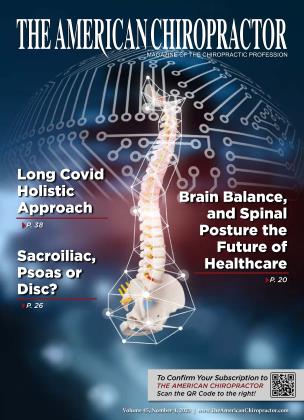Sacroiliac, Psoas, Disc or all of the Above?
DECOMPRESSION
Richard E. Busch
III, DC
Treating patients without surgery and pain pills has always been my primary goal. I am focused on getting my patients off the medical merry-go-round. I became involved with nonsurgical spinal decompression early in my practice, and my patients’ outcomes have been outstanding.
I have successfully treated thousands of patients with herniated and degenerative discs, spinal stenosis, sciatic pain radiculopathies, and neuropathies. When treating patients with these conditions, I primarily utilize spinal decompression, which is an integral part of my DRS Protocol. Spinal decompression combined with other therapies wifi help achieve maximum medical improvement and consistently resolve a patient’s pain, returning them to a normal and productive lifestyle.
One common complaint some patients have after a spinal decompression treatment(s) is chronic pelvic instability, even though there has been some or complete resolution of their radicular symptoms and back pain. Let me set the stage for you about this type of patient.
A new patient presents with a chief complaint of low back pain and pain radiating down one or both legs — often to the feet. The patient also complains of muscle weakness, decreased range of motion, and numbness and tingling in the legs and feet.
After a complete case history, exam, and films, the new patient is accepted for care and treatment with my spinal decompression protocol. The plan wifi be six to eight weeks. During that time, the patient responds very well to care, experiences less pain in the back and legs, and the paresthesia begins to dissipate. However, periodically during treatment, there is a complaint, such as, “My hip keeps going out.”
In many of these cases, the patients have had problems with a SI joint subluxation for years. Although a chiropractor had treated them frequently, their SI joint or hip continued to “go out.”
Some patients had medical treatments for pelvic instability and SI joint pain that included oral steroids, nonsteroidal anti-inflammatories like Mobic, and SI joint injections. While these may offer some short-term relief for inflammation, they regrettably do not treat the underlying condition. The problem often is a longstanding pelvic instability that includes muscles, ligaments, and tendons, which may be weakened and damaged by medical treatments.
The discomfort of a SI joint subluxation after spinal decompression can be a good sign because it may indicate the “retracing” of symptoms. For example, patients will say, “I haven’t had this problem for a long time,” or, “This feels exactly like it did when my back problems began.”
At this point, I must question the underlying cause of the instability. It could be muscle weakness, biomechanical alterations in the hips, knees, and feet, gait alterations after treatment, or even a nutritional issue, such as a protein deficiency. Determining nutritional deficiencies involves specific training, and I plan to address this topic in the future.
Initially, I wifi check for the old “leg length discrepancy” and perform Deerfield checks. Seeing the leg change from short to long is frequently involved and is a positive Deerfield. This finding indicates an anterior superior ilium (AS) on the side of involvement. Patients who have had disc problems can also have SI joint instability, which may show up as AS.
It is important to note that patients who have undergone spinal decompression may have spinal instability after a treatment. Therefore, I do not treat with a side posture adjustment. I use pelvic drops. I check the AS on the same side of involvement and use an AP drop to adjust the AS and the anterior sacral base.
I then check for psoas contracture, and the easiest method is to have patients extend their arms over their heads while lying supine. Check for a short arm; the short arm is the side of iliopsoas involvement.
There are several ways to release the psoas muscle. You can treat with an adjusting instrument or apply stretching techniques. I prefer the adjusting instrument applied directly over the top of the psoas. I am also checking for inguinal ligament contracture and medial thighs with the leg adductor muscles. These muscles are often contracted, and I use an adjusting instrument to create a fast stretch of the muscles and to release the contractions. This technique is excellent for relaxing muscles, hips, pelvic abductors, and the lumbar spine, which all help relieve pain.
The following will aid in releasing of psoas and other muscle contracture: cobra stretches, pelvic tilts, and hip flexor stretches. Pelvic tilts, unweighted deep knee bends and squats, lunges, and lumbar bridges will help with mobility and strengthen pelvic muscles.
I check ankles and knees, as they are often involved following radiculopathies. Adjusting the involved segments, whether in the knees or ankles, specifically the calcaneus and talus, takes pressure off these structures and affects the function of the hips and pelvis. I assess the whole patient. Where pain is experienced may not necessarily be the origin.
I highly recommend these techniques for patients with disc-related conditions and pelvic instability. By addressing these conditions, we can give patients the best results with lasting improvement and have them become referring machines for the future.
Dr. Richard E. Busch III has been in private practice in Fort Wayne, IN since 1996. He has built one of the largest spinal decompression and cash practices in the world. Dr. Busch has also trained many chiropractors and medical doctors in prepaid case fee cash practice. For more information go to Cashmasterpractice.com: 5005 Riviera Ct., Fort Wayne, IN. [email protected] or 888-471-4090.
 View Full Issue
View Full Issue












